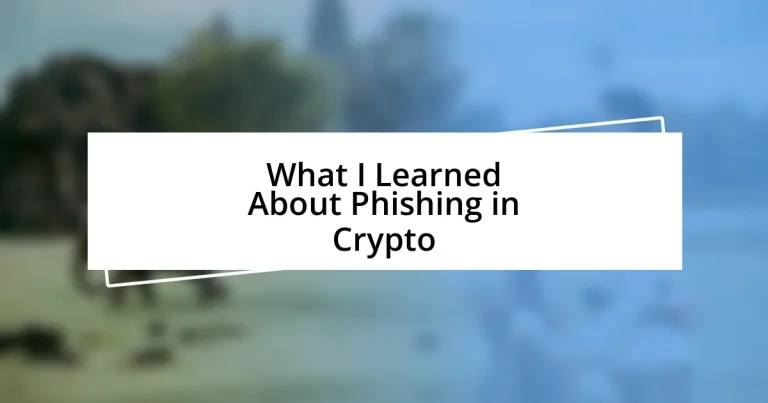Key takeaways:
- Common phishing techniques include fake websites, impersonating emails, and social engineering tactics that exploit trust.
- Recognizing phishing attempts involves checking URLs, looking for generic greetings, and being cautious of urgent requests and poor grammar.
- Effective prevention strategies include enabling two-factor authentication, educating oneself and others, and keeping software updated.
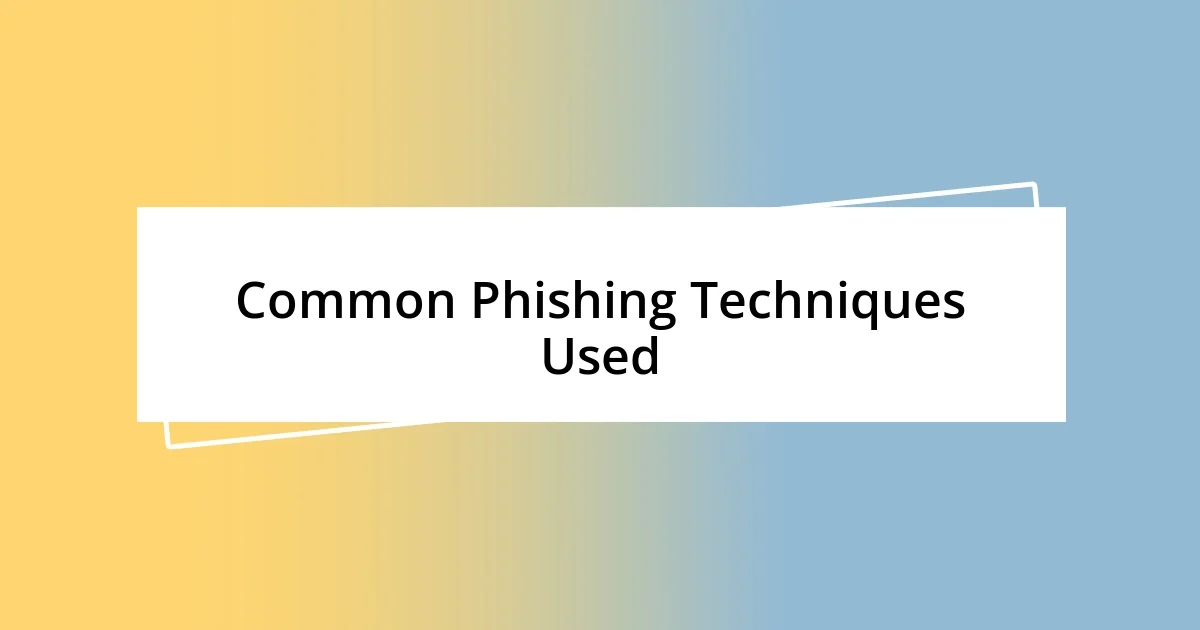
Common Phishing Techniques Used
One of the most prevalent phishing techniques I’ve encountered in the crypto space is the fake website tactic. Imagine clicking on a link that looks just like a well-known exchange, only to realize too late that every bit of information you input is now in the hands of a scammer. It’s like walking into a perfectly copied store, only to find out that the cash register is a trap waiting to rob you blind. How can we protect ourselves from such a convincing ruse?
Another common method I’ve seen are phishing emails that impersonate popular crypto wallets or services. These emails often feature urgent language, urging you to “confirm your account” or “claim your bonus” through a suspicious link. I remember receiving one that felt so genuine – it even had my name and transaction details! Just think, if I hadn’t paused to double-check the email address, I could have easily fallen victim. This makes me wonder: how often do we rush into action without verifying the sources we’re dealing with?
Social engineering plays a significant role, as well. Scammers have an uncanny ability to create a sense of trust by posing as technical support agents. I’ve had friends share stories of receiving calls claiming to be from their wallet provider, supposedly offering help to secure their accounts. The emotions tied to these calls are intense; fear and urgency make it easy to forget the fundamental rule: always validate the identity of the person on the other end. How often do we let our guard down when someone claims to have our best interests in mind?
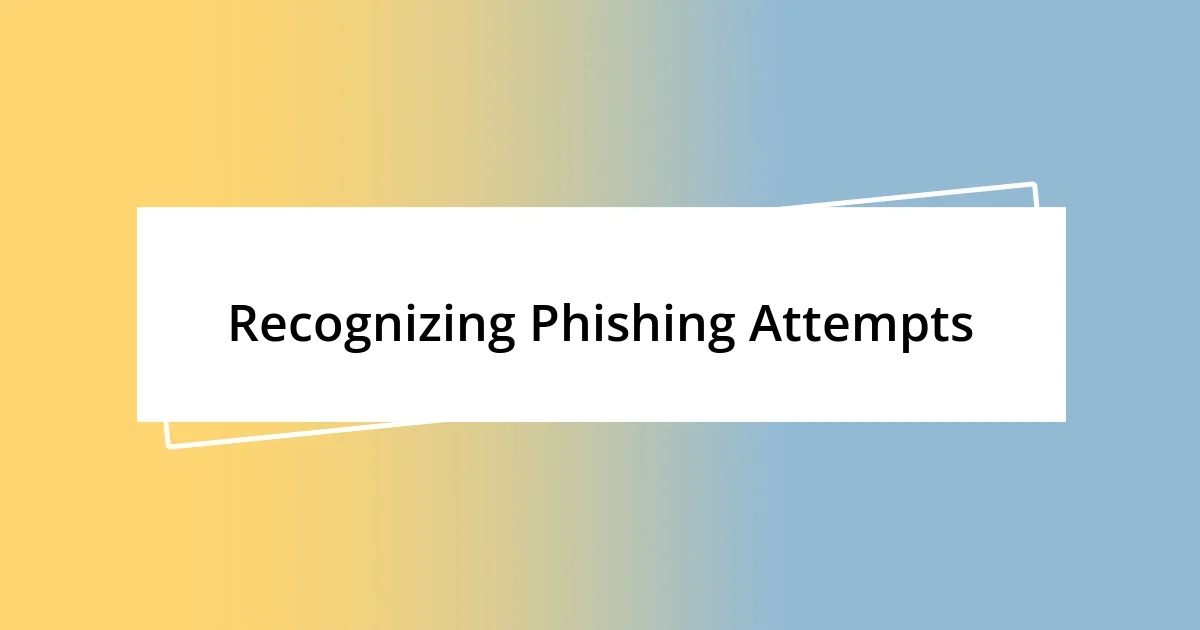
Recognizing Phishing Attempts
It’s amazing how easily phishing attempts can disguise themselves in the crypto world. Just last week, I received a message that appeared to be from a popular cryptocurrency exchange. The urgency in its tone was palpable, claiming I needed to secure my account immediately. I felt that twinge of panic, but my instincts kicked in. I paused, and I checked the URL carefully, only to discover a slight misspelling. It’s incredible how a minor detail can make all the difference.
To help spot these threats, here are a few red flags I’ve learned to recognize:
- Mismatched URLs: Always check the web address; a slight alteration can be a major indicator of a fake site.
- Generic Greetings: Legitimate communications usually address you by your name, not just “Dear User.”
- Urgent Requests: Be wary of messages that invoke urgency, pushing you to act quickly without thinking.
- Poor Grammar or Spelling: Scammers often overlook these details; professional language is a hallmark of genuine communications.
- Unreasonable Offers: If it sounds too good to be true, it probably is.
By keeping these tips in mind, I feel more confident navigating the digital landscape and steering clear of potential traps. It’s all about developing a sense of awareness and being a little skeptical; after all, staying safe in this space can be a real game changer!
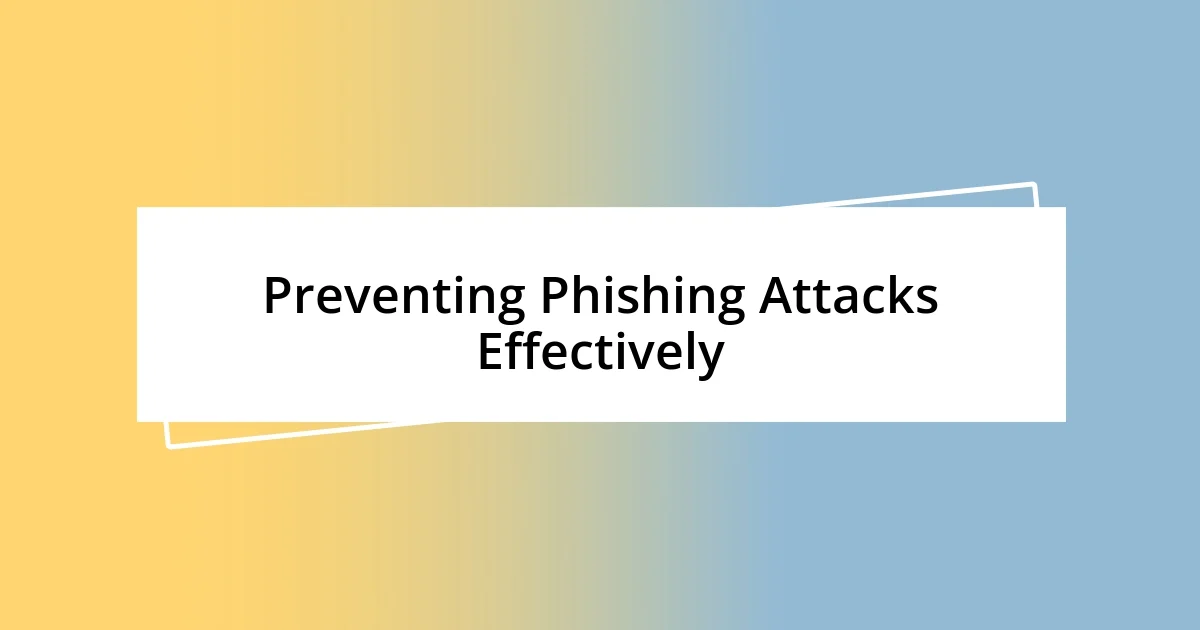
Preventing Phishing Attacks Effectively
Preventing phishing attacks is all about vigilance and adopting best practices. One of the most effective strategies I’ve implemented is enabling two-factor authentication (2FA) on all my accounts. This additional layer of security not only requires a password but also a code sent to my phone, making it significantly harder for someone to access my information. I can’t stress enough how much peace of mind this brings – like having a solid door lock that only I hold the key to.
Another crucial step is educating myself and others about the latest phishing tactics. I distinctly remember a time when a friend almost lost a substantial amount of crypto because he ignored a simple tip: always hover over links before clicking them. He clicked a link that led him to a fake customer support chat, and suddenly, everything was at stake. Sharing knowledge is powerful; the more we talk about these risks, the more armed we become. It’s about building a community of informed users who can watch each other’s backs.
Additionally, regular updates to software and wallets cannot be overlooked. When I received a notification to update my crypto wallet app last month, I was tempted to postpone it – after all, I was in the middle of a busy day. However, I realized that these updates often include important security patches that help protect against vulnerabilities. Now, I make it a point to prioritize updates as a part of my routine. Even a few minutes invested in security can save significant heartache down the road.
| Prevention Method | Description |
|---|---|
| Two-Factor Authentication (2FA) | Adds an extra security layer requiring both a password and a second verification method. |
| Educate Yourself | Stay informed about phishing tactics and share knowledge with others to enhance collective security. |
| Regular Updates | Keep all software and wallets updated to protect against security vulnerabilities. |
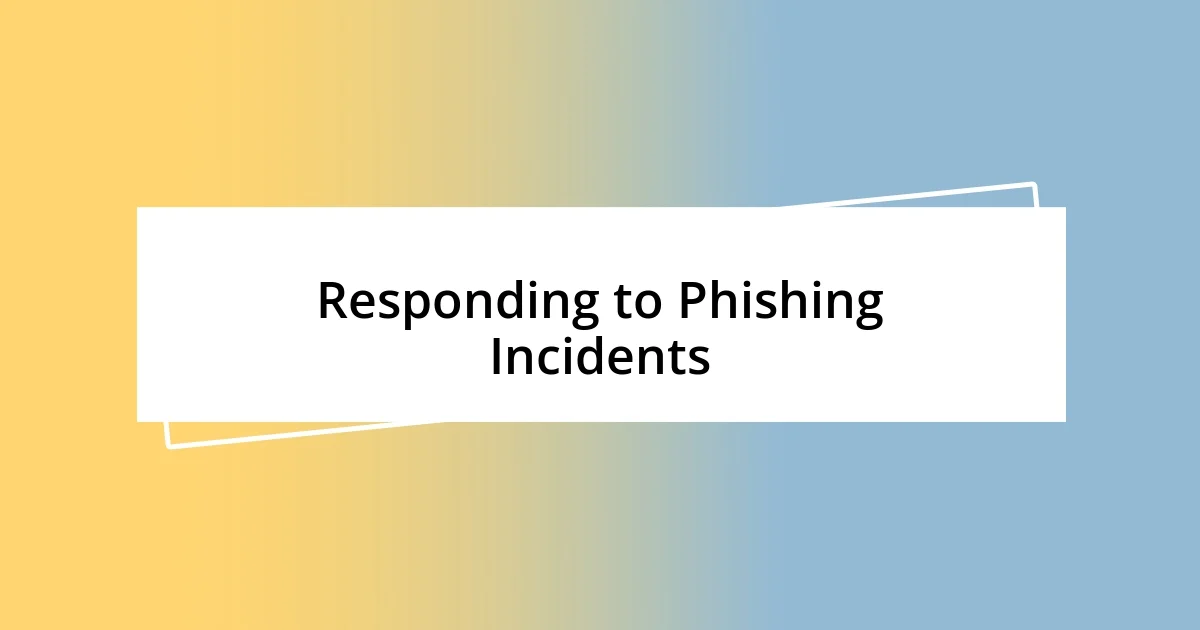
Responding to Phishing Incidents
When I found myself on the receiving end of a phishing attempt, my heart raced, but I quickly learned the importance of a calm response. Instead of panicking, I reported the incident to both my cryptocurrency provider and the relevant support forums. This action not only helped to protect my account but also contributed to a broader awareness within the community. Have you ever considered how your quick actions can alert others and potentially prevent further scams?
After that experience, I realized that documenting such incidents was crucial. I started keeping a log of phishing attempts, noting the details and methods used. By sharing this log with friends and online groups, we were able to identify patterns and learn from each other’s missteps. It’s like having a shared journal of experiences that can empower us to better protect our digital assets. Have you thought about what your own “phishing diary” could look like?
On a more practical note, I’ve become vigilant in changing my passwords immediately after any suspicious email or message surfaces, even if I don’t react hastily. I remember one time, after a friend lost their crypto due to a deceptive email, I made it a point to address my password security as a priority. It’s amazing what a strong, unique password can do—kind of like a secret handshake for your crypto. So, when was the last time you revisited the security of your accounts?
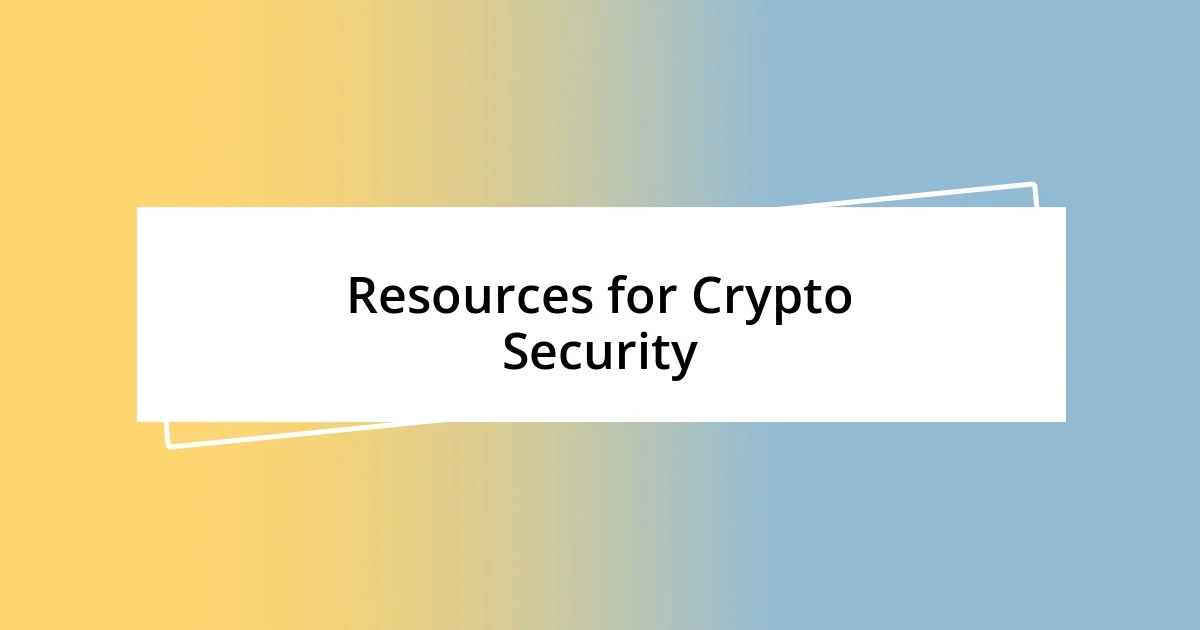
Resources for Crypto Security
It’s hard to overstate the value of using trusted resources for crypto security. I remember diving into the world of cryptocurrency without a solid understanding of the best practices. I stumbled upon websites that offered comprehensive guides on secure transactions and recommended tools, which made a world of difference. If you find yourself lost, I highly recommend checking out platforms like CoinMarketCap and CryptoCompare, which provide risk assessment and wallet comparison tools that are invaluable.
Books also play a significant role in my education on crypto security. I recently finished reading “Mastering Bitcoin” by Andreas M. Antonopoulos, and it opened my eyes to the technical aspects of blockchain that tie directly into security measures. Having that foundational knowledge enabled me to appreciate why certain methods, like hardware wallets, are so crucial. Do you think investing time in reading could elevate your own understanding and security strategies?
Moreover, engaging with online communities, such as Reddit’s r/CryptoCurrency, has proven instructive. I vividly recall a thread where users shared their phishing experiences and preventive steps they took afterward. It’s like a mini-support group for anyone feeling the strain of navigating this complex landscape. Seeking advice and sharing experiences in these forums not only equips you with knowledge but also reassures you that you’re not alone in this journey. What’s the last piece of advice you received that made you rethink your security practices?
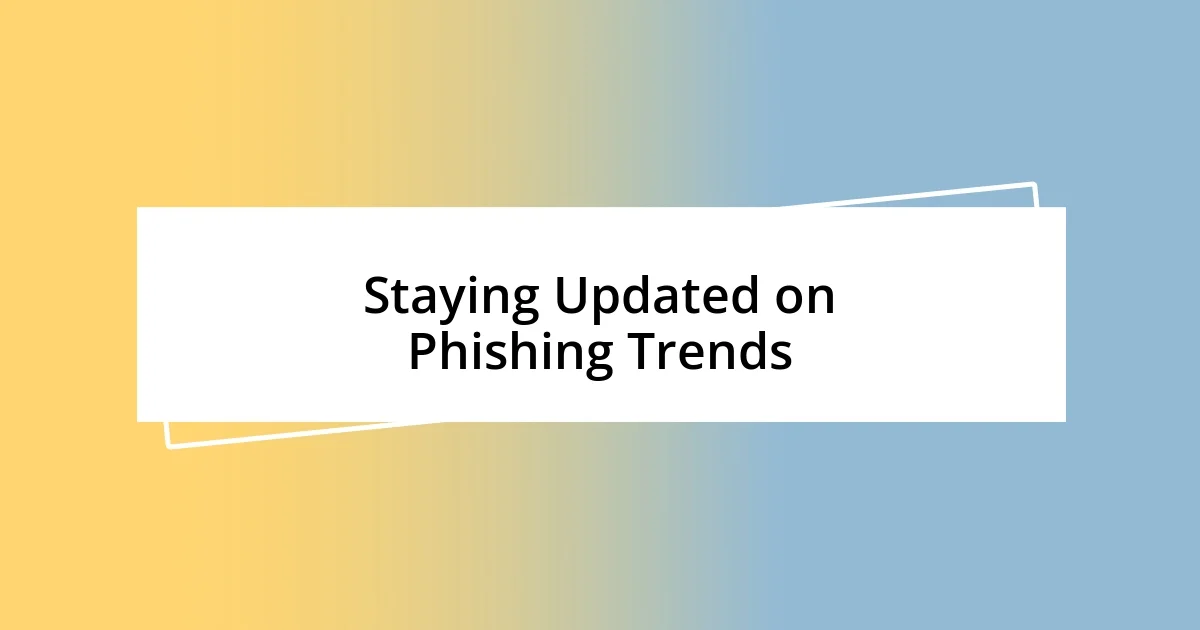
Staying Updated on Phishing Trends
Staying updated on phishing trends is an ongoing journey that requires commitment. I recall one evening when I stumbled across a news article discussing a surge in phishing emails targeting crypto wallets. It hit home because I had recently received one that was nearly indistinguishable from a legitimate communication. Have you ever felt that unsettling mix of curiosity and fear when recognizing a trend that could impact your own security?
Following trusted sources and channels has made a significant difference in how I perceive threats. For instance, subscribing to newsletters from cybersecurity firms has not only informed me about new phishing tactics but has also provided me with tips on how to fortify my defenses. It’s surprising how often simple steps can save you from a potentially devastating loss. How often do you check credible news sources to stay in the loop?
Additionally, I make it a habit to participate in webinars and discussions that focus on the latest phishing tactics in the crypto space. Just last month, I attended a session where experts dissected recent phishing schemes and discussed prevention measures. Sharing these experiences and insights with friends has created a sort of safety net for us all. Isn’t it comforting to think that staying informed is not just an individual effort but a collective one?












